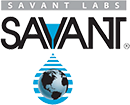Shear Stability and Viscosity Loss
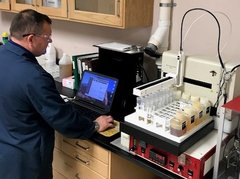 Shear stability is an important aspect of lubrication. Most multigrade lubricants are formulated with viscosity modifiers in order to
increase the viscosity index (VI) to ensure the lubricant can
provide a sufficient film thickness to protect the equipment or
engine from wear. Viscosity modifiers (VM) tend to be polymer
based chemistry that are susceptible to shear thinning. When a
lubricant undergoes shear thinning, the viscosity of the fluid can be
lowered by an entire ISO grade leaving moving parts in danger of
wear or seizure. To ensure the stability of the fluid’s viscosity,
tests are performed to analyze behavior under shear stress and
temperature.
Shear stability is an important aspect of lubrication. Most multigrade lubricants are formulated with viscosity modifiers in order to
increase the viscosity index (VI) to ensure the lubricant can
provide a sufficient film thickness to protect the equipment or
engine from wear. Viscosity modifiers (VM) tend to be polymer
based chemistry that are susceptible to shear thinning. When a
lubricant undergoes shear thinning, the viscosity of the fluid can be
lowered by an entire ISO grade leaving moving parts in danger of
wear or seizure. To ensure the stability of the fluid’s viscosity,
tests are performed to analyze behavior under shear stress and
temperature.
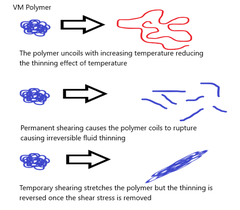 There are two types of viscosity loss from shear, temporary and permanent. Temporary viscosity
loss is where polymers in the fluid are stretched which cause thinning. However, this thinning is
reversible once the shear stress is removed. Permanent viscosity loss is not reversible as shearing
the fluid causes breakdown of the polymer by rupturing the macromolecular chains. When the shear
stress is removed, the viscosity remains lower and never returns to the level intended when the
lubricant was formulated. Shear stability is a key attribute lubricant formulators work to optimize
based on the requirements of the engine manufacturers as new technologies are developed.
There are two types of viscosity loss from shear, temporary and permanent. Temporary viscosity
loss is where polymers in the fluid are stretched which cause thinning. However, this thinning is
reversible once the shear stress is removed. Permanent viscosity loss is not reversible as shearing
the fluid causes breakdown of the polymer by rupturing the macromolecular chains. When the shear
stress is removed, the viscosity remains lower and never returns to the level intended when the
lubricant was formulated. Shear stability is a key attribute lubricant formulators work to optimize
based on the requirements of the engine manufacturers as new technologies are developed.
We will discuss the equipment and methods used to induce permanent shear in order to study the shear stability of a lubricant. Three of the common instruments used to permanently shear-degrade lubricants are the Kurt Orbahn or Bosch Injector, Sonic Shear, and KRL (tapered roller bearing).
Kurt Orbahn or Bosch Injector
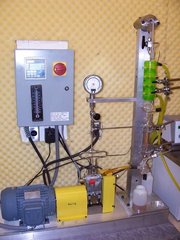 The Kurt Orbahn or Bosch Injector is associated with many
methods differing mainly by the number of cycles the lubricant is
passed through the injector. This test is designed to mechanically
shear the lubricant. The lubricant is sheared when it is passes
through a pintle orifice at a pressure of 13 to 18 MPa spraying and
atomizing the oil in each pass. It is considered the least severe
shearing method of the three discussed here. This method is
typically used for engine oils and hydraulic fluids. Savant Labs
offer ASTM D6278 Kurt Orbahn Shear Stability, 30 Passes and
D7109 Kurt Orbahn Shear Stability, including 30 and 90 Passes.
Both tests are ISO/IEC 17025:2005 accredited with this
apparatus. Savant can also do custom testing to alter the number
of cycles for other similar standards.
The Kurt Orbahn or Bosch Injector is associated with many
methods differing mainly by the number of cycles the lubricant is
passed through the injector. This test is designed to mechanically
shear the lubricant. The lubricant is sheared when it is passes
through a pintle orifice at a pressure of 13 to 18 MPa spraying and
atomizing the oil in each pass. It is considered the least severe
shearing method of the three discussed here. This method is
typically used for engine oils and hydraulic fluids. Savant Labs
offer ASTM D6278 Kurt Orbahn Shear Stability, 30 Passes and
D7109 Kurt Orbahn Shear Stability, including 30 and 90 Passes.
Both tests are ISO/IEC 17025:2005 accredited with this
apparatus. Savant can also do custom testing to alter the number
of cycles for other similar standards.
Sonic Shear
The sonic shear test irradiates the lubricant in a sonic oscillator for a set period of time. This test is
often used in the hydraulic fluid industry for specifications. It has also been successfully applied to
transmission fluids and tractor fluids. The shearing mechanism in this testing is cavitation of the
fluid. This mechanism differs from the mechanical shear tests, but there is a good correlation when
comparing the same VM additive or additives in the same or similar chemical family. Savant offers
test methods ASTM D2603 Sonic Shear for Oils and ASTM D5621 Sonic Shear for Hydraulic Fluids.
KRL (Tapered Roller Bearing)
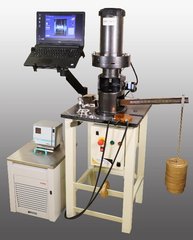 The KRL shear test uses a tapered rolling bearing in a cup fitted to
a four ball instrument. Load is applied to the bearings as they are
rotated at a certain RPM for a specified length of time. The test is
typically run for 20 hours. KRL is considered to be one of the
most severe shear tests and is used for driveline fluids and gear
lubricants. The unit can perform standard methods such as CEC
L-45-A-99, DIN 51350/6, and ISO 26422:2014. Savant offers CEC
L-45-A-99 Modified for KRL testing.
The KRL shear test uses a tapered rolling bearing in a cup fitted to
a four ball instrument. Load is applied to the bearings as they are
rotated at a certain RPM for a specified length of time. The test is
typically run for 20 hours. KRL is considered to be one of the
most severe shear tests and is used for driveline fluids and gear
lubricants. The unit can perform standard methods such as CEC
L-45-A-99, DIN 51350/6, and ISO 26422:2014. Savant offers CEC
L-45-A-99 Modified for KRL testing.
Viscosity Loss
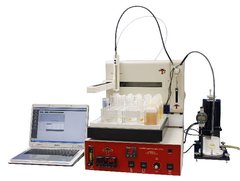
With each of the shear degradation methods, the viscosity is analyzed before and after the permanent shearing of the fluid. The fluid can be analyzed with ASTM D445 Kinematic Viscosity to determine the Permanent Shear Stability Index, per ASTM D6022. The fluid viscosity can also be analyzed under high temperature high shear (HTHS) conditions using the Tapered Bearing Simulator (TBS) and a low shear rotational viscometer.
Before and after viscosity values at both high shear and low shear rates are used to construct a Viscosity Loss Profile (VLP) from which the overall viscosity loss can be uniquely calculated and visualized. The VLP gives a simple visual appraisal of a fluid’s efficiency and effectiveness. Many examples of this data can be accessed through the Institute of Materials Online Database.
Custom Testing
Test methods are often written to address a need for testing consistency across a range of lubricants or applications. When working on an application that requires testing at custom defined parameters, Savant Labs have extensive experience in running modified test methods and reviewing the data to ensure meaningful results. In just one example, a major lubricant supplier collaborated with Savant Labs to modify a test to simulate the harshest conditions an oil might experience in a specific application. The results instilled confidence in the supplier's formulation.
If you would like to discuss shear stability options or learn more about the testing capabilities
available at Savant Labs, please contact us.
